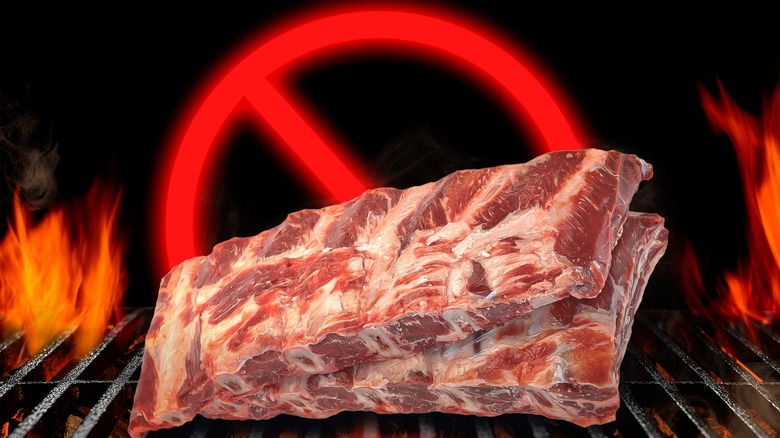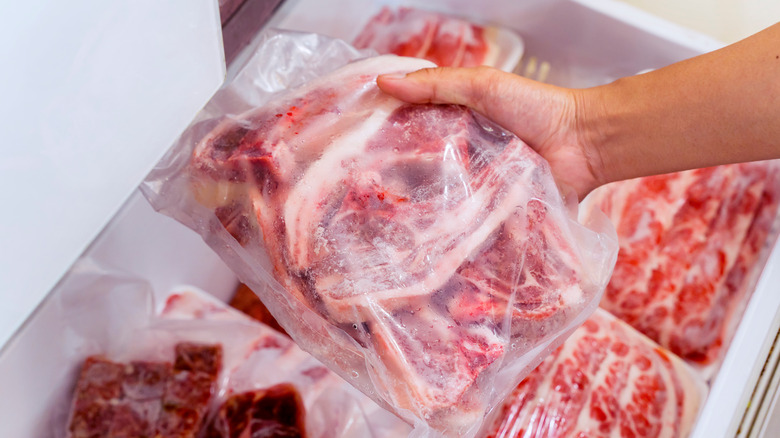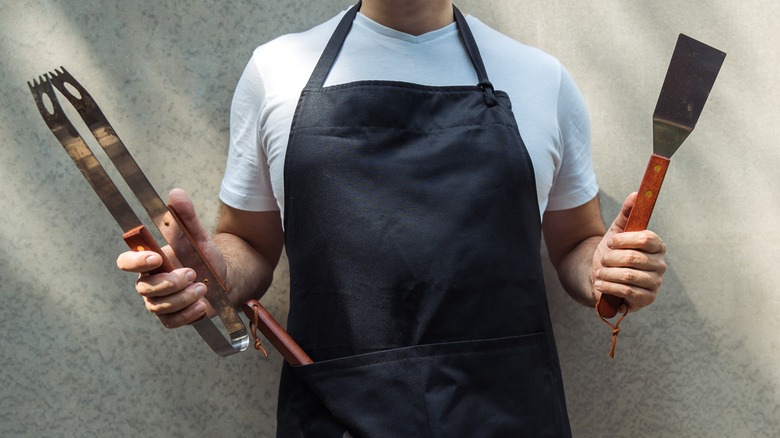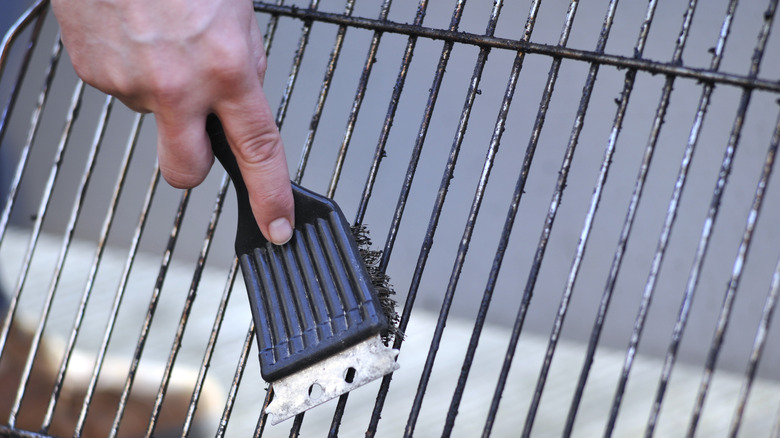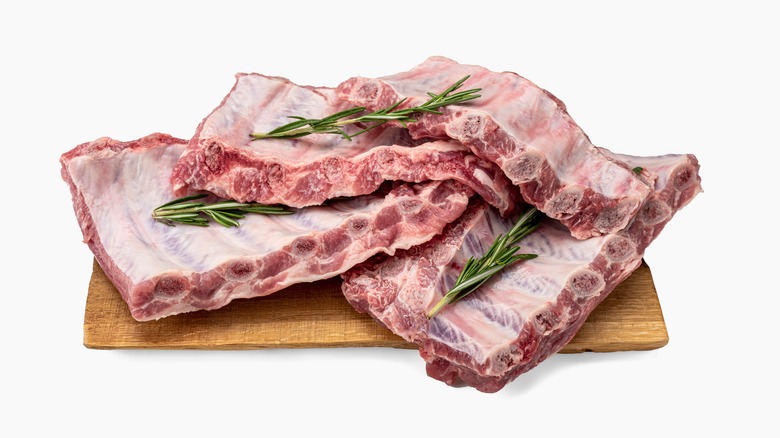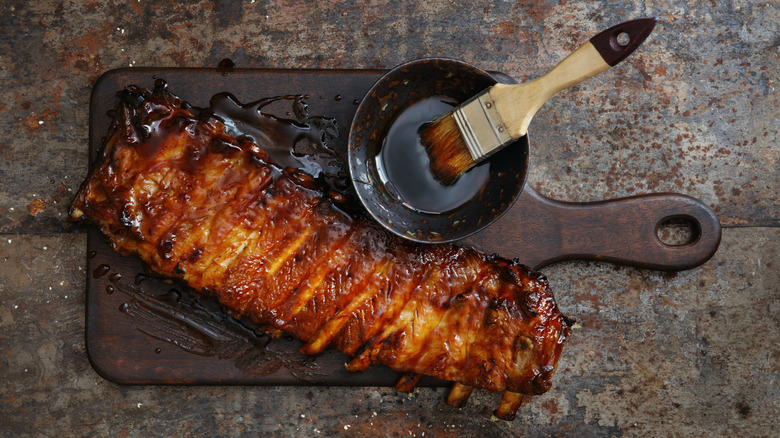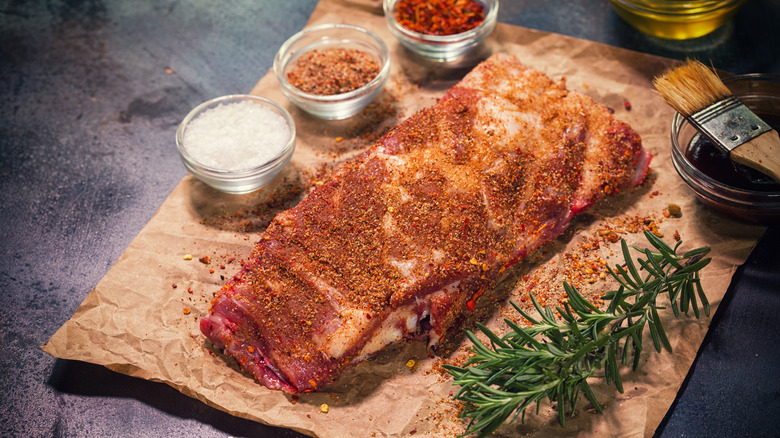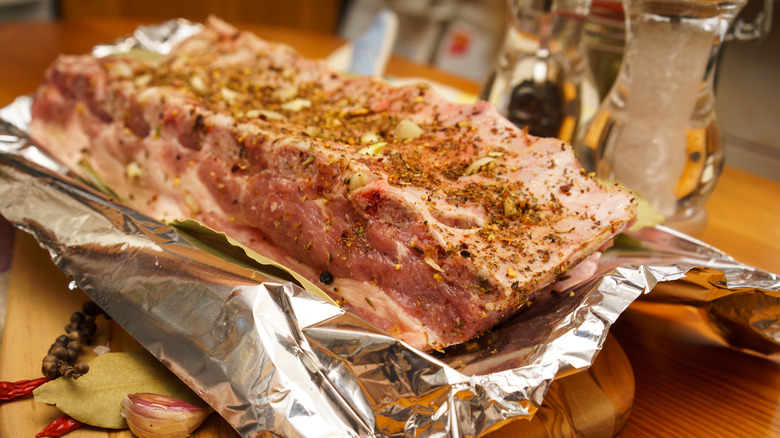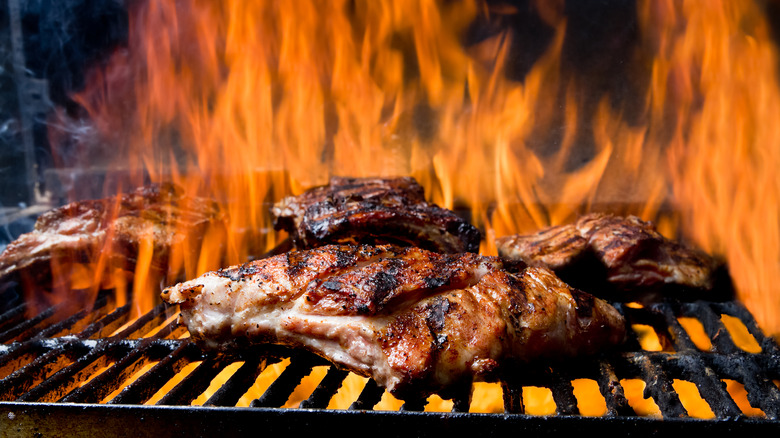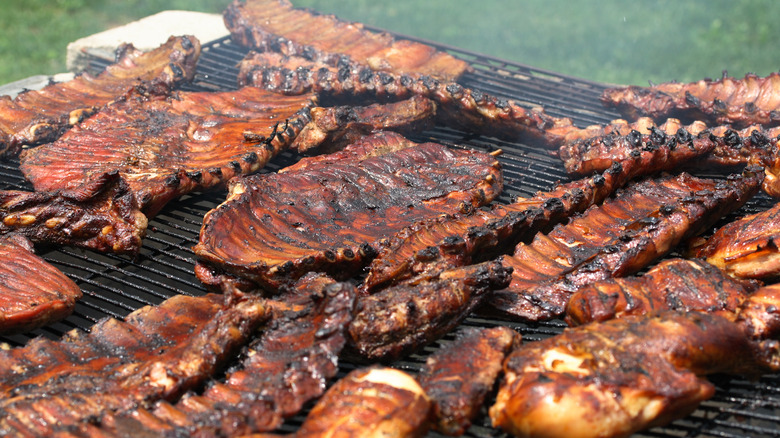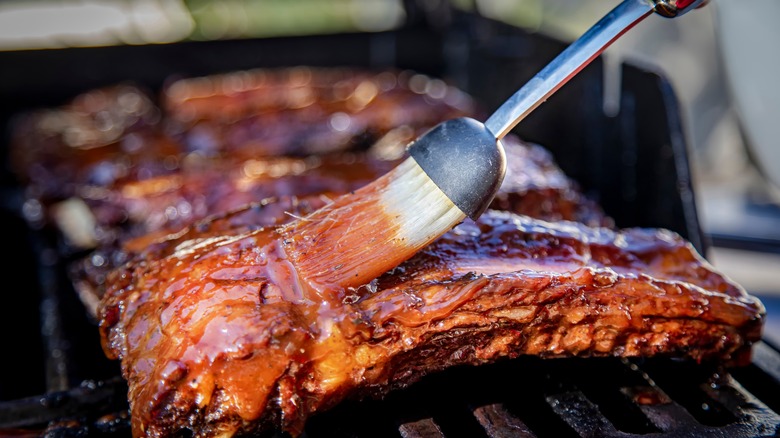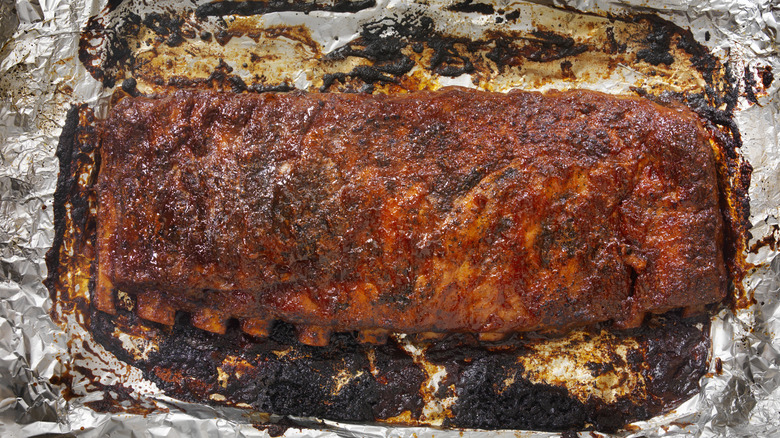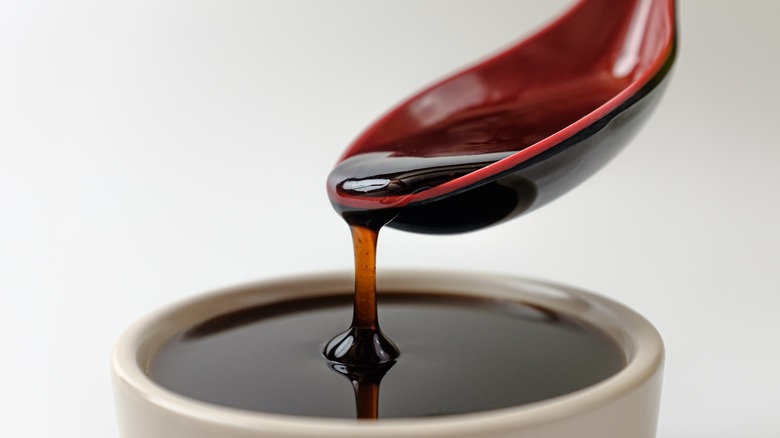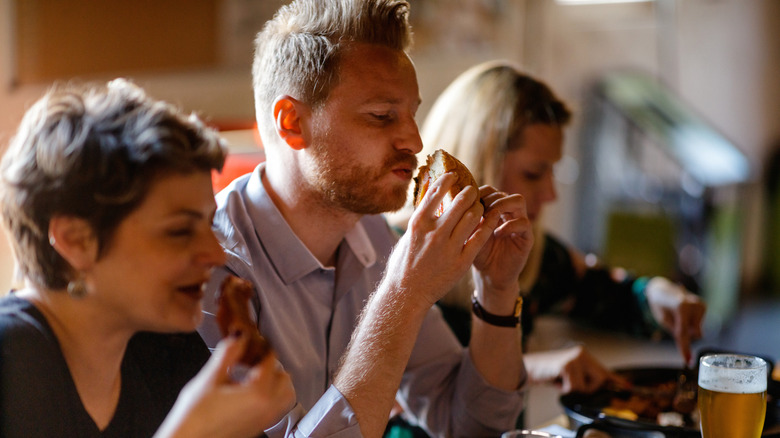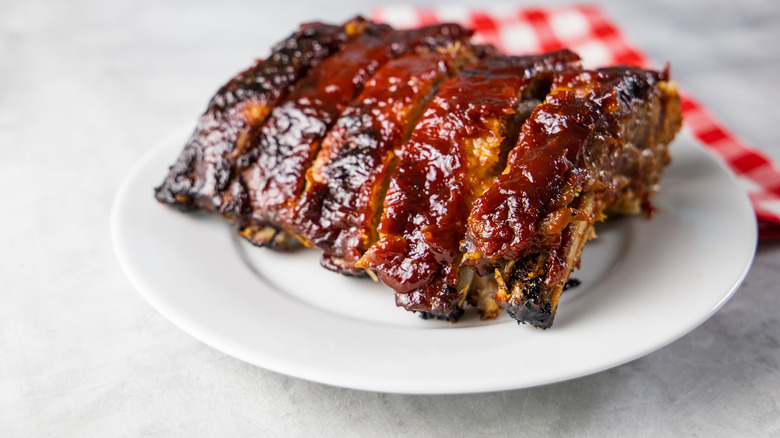14 Mistakes You Could Be Making When Cooking Ribs
Ribs are one of those foods that can be finger-licking good. The tender pork or beef combined with a favorite barbecue sauce is such a winning combination. Cooking your own ribs at home puts you in greater control of the sauces and seasonings and is also much more cost-effective than ordering ribs in a restaurant. Plus, ribs are one of the best foods to serve at a backyard barbecue when you're looking to really impress your guests.
However, as scrumptious as they can be, there is no guarantee your ribs are going to turn out as expected and desired. In fact, there are several potential obstacles and mistakes that can impede your goal of tender, juicy, and fall-off-the-bone ribs. Let's take a look at some of these mistakes that you'll want to avoid the next time you prepare ribs. Then, you can feel confident that your ribs will turn out delicious and safe to enjoy.
1. Not choosing the right ribs at the grocery store
The first step in making the most delicious ribs starts when you're at the grocery store or butcher shop. You need to decide whether you want to cook pork ribs or beef ribs. However, for the purpose of this article, we're going to assume you're cooking pork ribs. Even after you've decided to make pork ribs, there are different types of pork ribs to consider. One of the most popular types is baby back ribs because they are lean and meaty.
You may also want to try spare ribs — which have flatter bones and more connective tissues, making them very tender after slow cooking. St. Louis-style ribs are one type of spare ribs that have had the rib tips removed. This removal gives them more of a rectangular shape. Note that St. Louis-style ribs can be more challenging to cook, so you might not want to attempt them until you have some experience under your belt.
After you've decided on which type of pork ribs you want to cook, you need to choose the best package from what's available at the grocery store. Pay attention to the size of the package, looking for one that is on the heavier side to make sure you get enough meat. You also want to try to look through the packaging at the fat and marbling. Marbling is good, but you don't want the ribs to have an exorbitant amount of fat.
2. Not having the proper tools
Before you can cook ribs, you need to make sure you're prepared with all the tools and supplies you'll need. The last thing you want to do is to open up the package and start following a recipe on the day of your event, only to realize that you don't have something you need. This is going to leave you scrambling to find a substitute and could impact your ability to cook the ribs properly.
Of course, the tools you'll need to cook the ribs will vary based on the cooking method you plan to use. If you are going to be grilling the ribs, you'll obviously need a grill. Other necessary tools include grilling utensils, such as tongs, a spatula, and a fork. If you'll be cooking the ribs in the oven, you'll need a large shallow tray. Regardless of which cooking method you choose, you'll also need aluminum foil, a basting brush, a meat thermometer, a large cutting board, and a sharp knife to cut the ribs after they've finished cooking.
3. Not cleaning the grill first
Another important thing to do before you actually plan on cooking the ribs is to make sure that your grill is clean. If you didn't have time to clean the grill the last time you used it or simply forgot about it, you're risking changing the way your ribs will end up tasting, and not in a good way. The stuck-on meat and grease on the grate can get stuck to the ribs as they cook. Clearly, small pieces of charred meat on your freshly prepared ribs aren't going to taste good. Moreover, as some of these little bits of food drop down into the grill as you're cooking the ribs, they're going to make more smoke, which could also negatively impact the flavor of your ribs.
Leaving chunks of old food sitting on your grill for a few days — or weeks or months — is also just not healthy, according to Theochem Laboratories Inc. You're giving bacteria or mold the perfect place to grow and then transfer to your ribs. Beyond the way a dirty grill can impact how safe your ribs are to eat or how good they're going to taste, not properly cleaning your grill can also decrease its lifespan. You could miss identifying repair needs if the grill is too dirty to thoroughly check before and after each use. Leaving food on your grill can also attract bugs and rodents, which you certainly don't want anywhere near where you cook.
4. Not removing the membrane before seasoning or cooking
If you've never cooked ribs before — or have never been officially taught how to cook them — it is easy to overlook the important step of removing the membrane. At first glance, you may just assume that the membrane is more fat that should stay on when cooking the ribs. However, the membrane is really a piece of tissue that is on the bottom of the ribs. When the ribs cook, the membrane will not become softer or more tender like the meat and fat will. So, if you do not remove it before cooking, your ribs are going to taste too chewy. Another reason to make sure you remove the membrane is that it can block your seasonings and rubs from getting into the ribs. Your ribs won't be as flavorful as you hoped.
Fortunately, removing the membrane isn't difficult and will only take a few minutes of your time. Start by flipping the ribs over so that the membrane is facing up. You'll see the silver tissue attached to the back of the bones. Slide the tip of a knife under one corner of the membrane to pull it away from the bone. After you've loosened the membrane with the knife, it will be easiest to remove by pulling with your hand. Try to get a good grip on the membrane with one hand and hold the ribs with the other as you pull it off. It can be a bit slick, so you may need to be a bit persistent as you work to take it off.
5. Not marinating the ribs
While marinating ribs is not something you have to do before cooking them, it is definitely something you'll want to consider strongly. When you marinate your ribs, it works to make the meat more tender and less chewy. Marinades are acidic. Their acids work to break down the protein in the pork. As the protein gets broken down, it becomes more tender.
Because baby back ribs are already lean, marinating them is not as important. However, if you're planning on cooking spare ribs, country-style ribs, or St. Louis ribs, a marinade will be more important. These cuts have more connective tissue, which the marinade can help soften. Just take care not to marinate the ribs for too long — between 2 and 8 hours should be sufficient — otherwise, they may end up too soft after cooking. There are many different types of marinades and recipes you can follow, but many often include ingredients like vinegar, ketchup, Worcestershire sauce, soy sauce, olive oil, beer, chili powder, onion or garlic powder, and mustard.
6. Not making a dry rub for the ribs
Regardless of whether you marinate the ribs, you will definitely want to make a dry rub for them before cooking. If you're not familiar with what a dry rub is, let's start there. A dry rub is made using various herbs and seasonings. Once combined, the mixture is rubbed over the entire surface of the meat before it is cooked. Using a dry rub can help make your ribs more flavorful. Moreover, the combination of all of the different spices on their outside can also help give them more texture and a little bit of a crispy crust.
There are many different dry rub recipes out there. For example, if you want to try a sweet rib rub, you could combine brown sugar with spices such as cumin, onion powder, garlic powder, chili powder, and cinnamon. To recreate the Memphis-style dry rub, try starting with turbinado sugar and adding some Spanish paprika, garlic powder, onion powder, ground mustard, and other seasonings.
Once you've prepared your dry rub and removed the membrane from the ribs, you'll be ready to apply it. Pat the ribs dry using a paper towel, scoop the rub onto the ribs using one hand, and use the other hand to pat it down. Take care to cover both sides with a generous amount. Give the rub about 30 minutes to sit with the ribs in the refrigerator before moving on to cooking them. This will allow more of the flavors to penetrate the meat.
7. Not wrapping the ribs
Wrapping your ribs in foil is another important step that you don't want to skip. However, it isn't as simple as wrapping them up right before you put them on the grill. You need to wrap them at the correct time in the cooking process. Aim to wrap the ribs once they've reached an internal temperature between 175 and 180 degrees Fahrenheit or after about 2 to 3 hours. Once the ribs hit the set temperature, remove them from the grill, wrap them with aluminum foil, and return them to continue cooking.
The reason for wrapping ribs is that it helps them cook more quickly and ensures that they end up nice and tender. However, if you wrap them before you even put them on the grill — or too early in the cooking process — they won't get crispy from cooking directly on the metal grates. They also won't be able to absorb as much of the smoky flavor from the grill. After wrapping the ribs in foil, let them continue cooking for approximately 2 hours. After that time, remove the foil and put them back on the grill to finish cooking for about another hour.
8. Cooking the ribs at too high of a temperature
If you're going to follow just one rule when cooking ribs, let it be cooking them at the right temperature. It is so important to cook ribs slowly at a lower temperature rather than trying to cook them quickly at too high of a temperature. Trying to grill ribs over direct heat, as you would hamburgers, is surely going to leave you dissatisfied with the results. Rather than the meat turning out nice and tender and falling off the bone as you eat it, it is going to be way too tough to be very enjoyable.
When you cook ribs, leave them away from the direct heat of the grill. This allows them to cook more slowly and will give you the more tender results you're looking for. Cooking for a long time at a low temperature helps retain more of the moisture from the meat. Moreover, the longer cooking time also helps dissolve the tougher connective tissue in the ribs. Without these longer cooking times, the connective tissue will still be very tough, making the ribs much chewier than you want.
9. Cooking the ribs for too long
While low and slow is the name of the game when it comes to cooking ribs, cooking them for too long isn't good either. The longer cooking time does help with dissolving the tough connective tissue and ensuring the ribs turn out nice and tender, but it cannot be extended indefinitely. If ribs are cooked for too long, they won't taste good either. Overcooked ribs lose too much moisture, leaving them tough and dry.
So, what's the difference between just right and too much? There is no one right answer here because every rack of ribs is different, and the exact cooking methods will impact the results. The best way to determine if your ribs are ready to enjoy is by keeping an eye on the internal temperature. You want to aim for it to be right around 185 degrees Fahrenheit for the best taste and texture. Investing in a good digital meat thermometer will make it easier to monitor the internal temperature of your ribs to know when they are ready to remove.
10. Adding the barbecue sauce too soon
If you're making barbecue ribs for the first time, you might assume that the barbecue sauce should just go on right when you start cooking them. Doing so, however, would be a mistake. There is sugar in most barbecue sauces, which can burn at temperatures as low as 265 degrees Fahrenheit. If you add it to your ribs before cooking them — or too early during the cooking process — it can burn. This will impart a bad flavor to your ribs. Moreover, burnt sugars may also make it gummy, changing the texture of the ribs once they're cooked.
The best time to add barbecue sauce to your ribs is when they have almost finished cooking. About 30 minutes before you plan to take the ribs off of the grill, baste them with a brush. This will leave enough time to give the sauce the chance to caramelize a bit without letting it go so far as to start burning. As the ribs continue to cook, apply several more thin coats until you're ready to remove them.
11. Not broiling the ribs after cooking in the oven
Cooking ribs on the grill is not the only option you have. If you don't have a grill or simply prefer to use the oven, it can also help you make very tasty ribs. Just don't make the mistake of forgetting to broil the ribs for a few minutes before serving. The reason for broiling the ribs is that you want to give the barbecue sauce a chance to caramelize before enjoying the ribs. Skipping the broiler would be the equivalent of waiting to put the barbecue sauce on the ribs after they've already been removed from the grill.
The right time to broil your ribs is after they have finished cooking in the oven. Remove the aluminum foil from the ribs, then brush them using your favorite barbecue sauce — make sure to use a generous amount for the best taste. Then, place the baking sheet back in the oven and broil at high for about four minutes. You want to watch the ribs throughout the process and remove them when you notice the sauce caramelizing. Do not let them go so long that the sauce begins to burn.
12. Not considering a barbecue sauce alternative
There's no question that barbecue sauce and ribs go well together. However, just because barbecue sauce tastes good on ribs, it doesn't mean that other sauces won't also taste great on your ribs. If you realized that you ran out of barbecue sauce, aren't a fan of the way it tastes, or are feeling adventurous and want to try something new, there are several other alternatives to consider.
One good option is teriyaki sauce. Made with soy sauce, mirin, and sugar, teriyaki sauce is sweet and flavorful. It will give your ribs more of a unique taste that might make you think of some of your favorite Asian recipes. You could also try chimichurri sauce the next time you make ribs. A mix of cilantro, parsley, garlic, red pepper flakes, and white vinegar, chimichurri sauce will assist you in creating some flavorful and delicious ribs. If you've tried Argentinian steak, then you've likely had chimichurri sauce before and should know how tasty it is. A few other barbecue sauce alternatives you might want to consider include mustard sauce, hoisin sauce, Worcestershire sauce, and chili-garlic sauce.
13. Not making enough ribs to go around
Whether you're making ribs for an intimate dinner or grilling for a crowd, one of the last things that you want is to run out of ribs, leaving your guests still hungry for more. You need to plan for enough food for everyone you'll be serving, otherwise, both you and your guests are going to end up feeling disappointed.
It can be difficult to guess how much food each person will eat, but it is always better to plan for extra food than to end up not having enough. As a general rule for ribs, you want to assume each person is going to eat at least half a rack of baby back ribs, which works out to about six ribs each. If you're making spare ribs, your guests will likely eat fewer ribs since each one is bigger. For these, plan on at least five ribs each.
So, to figure out how many total racks of ribs you need to buy, you just need to complete a few simple math problems. Take the total number of guests who will be coming and divide it by two to determine how much to buy. For example, if you have eight guests coming, get at least four racks of ribs at the grocery store; that way, each person can have half a rack.
14. Not properly reheating leftovers
It's possible that you may end up cooking more ribs than everyone will be able to eat. Again, this is a better problem to have than not making enough ribs in the first place. Plus, if you do have some extra ribs left over, you can either send them home with your guests or save them for yourself to enjoy later. Just don't make a big mistake heating up the leftover ribs wrong — they could turn out too dry.
You can wrap the ribs up with some foil and put them back on your grill for a few minutes to warm them up slowly without removing too much of their moisture. But if you don't want to use the grill to reheat a few ribs, the oven can also help you. As with cooking ribs in the first place, you want to use the low and slow methods. Reheat the ribs at a lower oven temperature for several minutes rather than trying to heat them up quickly at a high temperature. If you choose a temperature that is too high, the ribs will dry out.
The best way to warm ribs up in the oven is to preheat it to 225 degrees Fahrenheit. As the oven is heating up, take the ribs out of the refrigerator to come to room temperature. Try to leave them out for about 30 minutes before putting them in the oven. Then, unroll a sheet of aluminum foil, and place the ribs on top of it. Brush on one more coat of barbecue sauce before wrapping the ribs in the foil and putting them in the oven. Heat them up for about 30 minutes but remove them sooner if they've warmed up.
